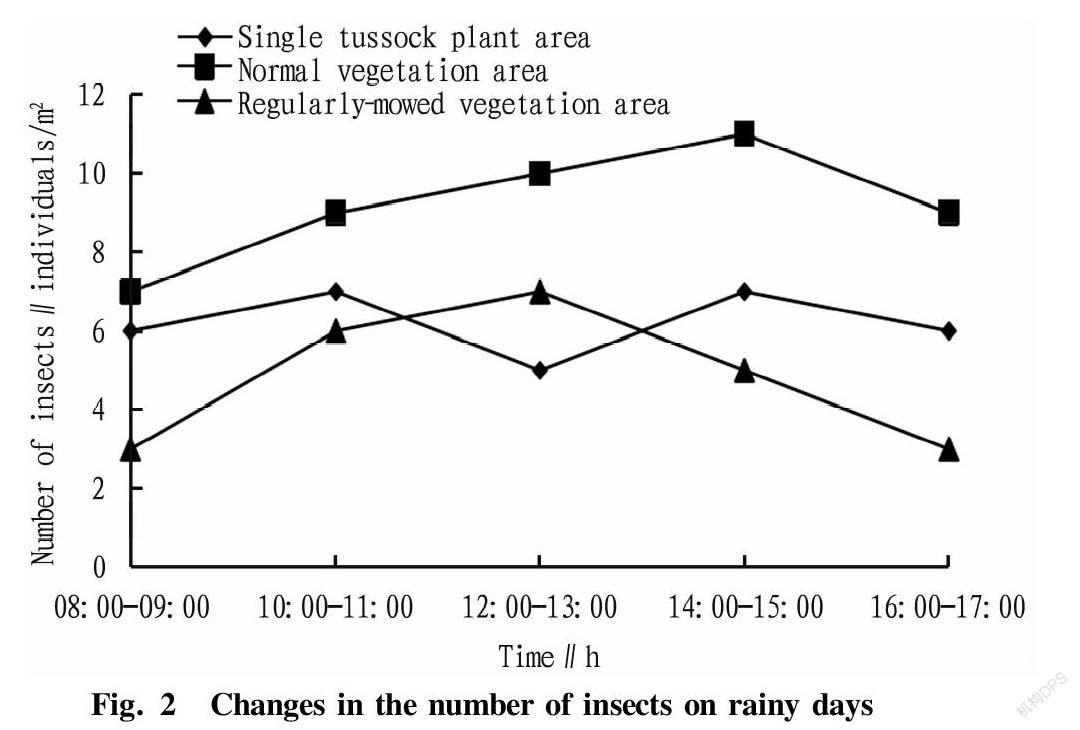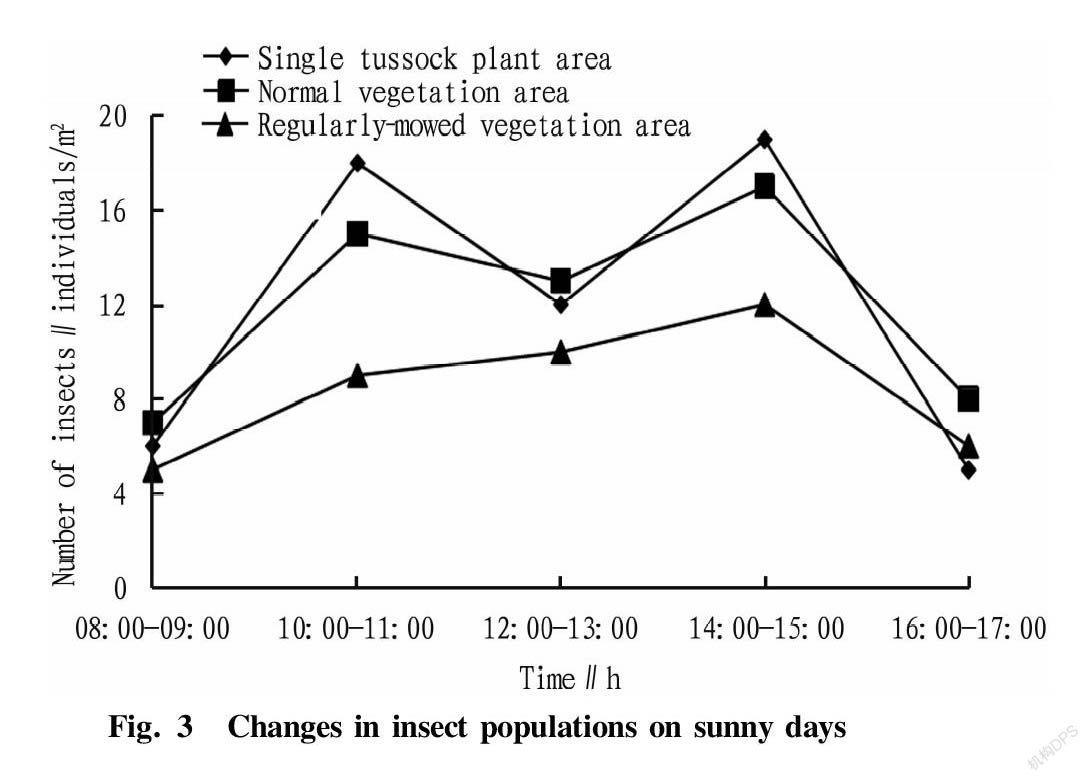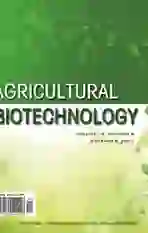Preliminary Study on Dynamic Changes of Insect Communities in Airport Ground Cover Areas in Different Weather Conditions
2021-01-03ZiyuanWANGShiquanLIShulanZHAOLi’anDUO
Ziyuan WANG Shiquan LI Shulan ZHAO Li’an DUO




Abstract [Objectives] This study was conducted to investigate insect activity rhythms in airport ground cover areas, and provide guidance for insect control and bird strike prevention.
[Methods]The daily rhythm of insects in the northern area of the airport was studied, and their activity rhythms and characteristics under different weather conditions were analyzed.
[Results] In rainy days, the insect number in the three sample areas was low. In cloudy days, insect activity was relatively stable, and insect number was consistent in the morning and evening, and maintained in a stable range, while in sunny weather, insect activity was increased, and the number changed greatly with time. For a single tussock plant growth area, the number of insects was at a relatively low level under rainy weather. In fine weather, the peak period of insect activity was between 10:00-11:00 and 14:00-15:00.
[Conclusions]This study can provide a reference for the formulation of safe flight departure time.
Key words Airport; Weather; Ground cover area; Insect community
Received: July 28, 2021 Accepted: September 29, 2021
Ziyuan WANG (1995-), male, P.R. China, master, devoted to research about insect ecology.
*Corresponding author. E-mail: zhaosl_tjnu@126.com; duolian_tjnu@163.com
The research on the daily rhythm of insect communities has been receiving more and more attention[1]. Relevant investigation and analysis of insect behavior rhythms can clarify the mechanism and influence factors of various insect behavioral rhythms[2]. Studies have shown that the most critical factor for bees to establish a circadian rhythm is light, and the peak period of bees’ flight is around 9:00 in the morning[3]. The research on the rhythms of insect communities in trematode towers found that most insects had a clear daily activity rhythm, and the activity rhythm of the Hymenoptera natural enemies of most aphids was very consistent with that of aphids, showing the phenomena of obvious following and accompanying migration[4].
Airport insects are food for birds. More insects will inevitably attract more birds to the airport for food, which will increase the probability of bird strikes. Therefore, studying the daily rhythm of airport insects is of great value in guiding the prevention and control of airport bird strikes. At present, the research on the daily rhythm of insect activities in the airport has not been reported in literatures. In the present study, the daily rhythm of key insects in the ground cover area of Tianjin Binhai International Airport was investigated. The aim is to provide new strategies for insect control and bird strike prevention in the airport, and provide a reference for other airports to spread relevant experience. Therefore, in Tianjin Binhai International Airport, research on daily rhythms of insects that strongly attracted birds and analysis of their activity rhythms can provide a reference for the formulation of safe flight departure time.
Study Methods
Study area
Tianjin Binhai International Airport is located on the east coast of the mid-latitude Eurasian continent. It is mainly dominated by the monsoon circulation, and has a continental climate with prevailing East Asian monsoons. It has four distinct seasons, including windy and drought spring with little rain, hot summer with concentrated rain, cool autumn with moderate temperature, and cold, dry winter with less snow. The annual average temperature is 11.4-12.9 ℃. The monsoon prevails, with the highest wind speeds in winter and spring, the lowest wind speeds in summer and autumn, and an annual average wind speed of 2-4 m/s[5]. The average annual precipitation is 520-660 mm, and the number of precipitation days is 63-70 d. The precipitation in June, July and August accounts for about 75% of the whole year. The sunshine time is long, and the annual sunshine hours are 2 500-2 900 h[6].
Sample plot characteristics
The experimental area was designated between the factory premises of the airport and the fire passage, with an area of approximately 1 500 m2. The survey was divided into three areas: the area where a single barnyard grass was planted, the area where vegetation was regularly mowed, and the area where normal plants grew. Plants in the single tussock plant area were mainly Echinochloa crusgalli , with a coverage close to 100%. Plants in the regularly-mowed vegetation area mainly included Setaria viridis, Cirsium setosum, Sonchus arvensis L., Inula japonica Thunb., Lepidium apetalum, Humulus scandens, Plantago depressa Willd., etc. , with a coverage more than 95%. The normal vegetation growth area was mainly composed of S. viridis, C. setosum, S. arvensis L., I. japonica Thunb., L. apetalum, Plantago depressa, Kochia scoparia, Rumex patientia, Chenopodium glaucum, Cynanchum chinense, Portulaca oleracea, Abutilon theophrasti, etc. , with a coverage close to 100%.
Experimental methods
Five experimental sample points were randomly designated in each survey area, with an area of 1 m×1 m. Cloudy, rainy and sunny weather were chosen. The climatic conditions on July 18 were cloudy with a temperature of 21-28 ℃. The weather on July 21 was rainy, with a temperature of 23-30 ℃ and a rainfall of 30 mm. The weather on July 25 was sunny, with a temperature of 25-33 ℃. A day was divided into 5 time periods, namely 8:00-9:00, 10:00-11:00, 12:00-13:00, 14:00-15:00, and 16:00-17:00. The number of insects in different time periods was recorded. The method of insect survey was using insect nets to patrol the plots at a fixed number of times, intensity, andrange, and recording the number and activity status of the insects and performing identification.
Data processing
The experimental data were processed using Excel 2013.
Results and Analysis
Insect community composition
A total of 157 insects were obtained from the investigation, belonging to 14 species in 7 orders of 13 families (Table 1). The dominant groups included Pieris rapae of Lepidoptera, Apis cerana cerana of Hymenoptera, Pantala flavescens and Ischnura asiatica of Odonata, Acrida cinerea and Teleogryllus emma of Orthoptera.
Changes in the number of insects under different weather
Under cloudy conditions, the number of insects in different vegetation types showed different trends (Fig. 1). In the normal vegetation area, the number of insects peaked at noon (12:00-13:00). The change in the number of insects in the mowing area was similar to that in the normal vegetation area, that is, the number of insects gradually increased from the early morning, and peaked at 14:00-15:00, but the increase was smaller, and the overall number was maintained in a low range.
Under rainy conditions, the number of insects varied in different areas (Fig. 2). In the normal vegetation growth area, the number of insects steadily increased from the morning, reached a maximum at 14:00-15:00, and then decreased slightly. The number of insects in the single tussock plant area and mowed vegetation area did not fluctuate greatly, and maintained at a low level. The number of insects in the normal vegetation area was higher than those in the single vegetation area and the mowed vegetation area. It could be seen that the change of of insect number under rainy conditions was not obvious, and was basically within a stable range.
In a sunny day, the number of insects varied greatly in different time periods, showing an M-shaped trend (Fig. 3). From the early morning, with the increase in temperature and light, the number of insects gradually increased, reached a maximum at about 11:00, decreased near noon due to the strong light, and then rose and reached the second peak at about 15:00. Finally, as the light was weakened, the activity of insects was reduced, and the number of insects decreased. In the three different vegetation environments, though the number of insects was different, the variation trend was basically the same, showing that climatic conditions have a greater impact on insects, and different environments determine the range of insect number.
Discussion and Conclusions
At present, there are few references on insect activity rhythms, most of which are about changes in insect rhythms in special environments such as granaries and fluke towers[4], and the research content is not comprehensive enough. In this study, we investigated insect number in the single barnyard grass planting area, the natural plant growth area and the regularly-mowed plant area at airport under different weather conditions, preliminarily studied insect daily activity rhythms, and basically clarified the daily insect activity rhythms of Tianjin Binhai International Airport in summer.
Under different weather conditions, the changes in the number of insects in different vegetation areas were consistent to a certain extent. The number of insects in normal vegetation growing areas was higher than those in the single vegetation area and the regularly-mowed vegetation area. In a rainy environment, the water vapor in the air and grassland is large, which is not conducive to insect activities. Therefore, the number of insects in the three ground cover areas was low, and there was not much fluctuation over time. In cloudy days, insect activities were relatively stable, and the number of insects was always within a stable range in the morning and evening, which might be due to that with weaker light and lower temperature in cloudy days, the appearance and activity of insectschanged little. On the other hand, on sunny days, insects’ activity increased, and the number of insects changed drastically over time, which was inseparable from the disturbance of the external environment, and further research is needed.
For the single plant growth area, the number of insects was at a low level under rainy weather, indicating that the activities of insects are greatly affected by the weather. In fine weather, the peak period of insect activities was between 10:00-11:00 and 14:00-15:00, which was closely related to changes in temperature and light. From the early morning, insects became active as the temperature and light gradually increased. The insects disappeared to avoid the strong light at noon (12:00), and the number of insects decreased. In the afternoon from 14:00 to 15:00, the light dropped slightly, and the temperature was suitable for insect movement. At this time, the number of insects reached a peak; and then as the temperature and the light decreased, the activity of insects gradually decreased, and the number of insects showed a downtrend. Some scholars have studied insect diversity in the eastern part of Hohhot, and showed that daily insect rhythms in different habitats exhibited different characteristics; and the number and abundance of insects in grassland and farmland had two peaks in the morning and afternoon, while insects in sparse forest grassland only peaked once in the morning, and remained stable during the rest of the time[7], which is similar to the results of this study.
In different vegetation areas, the number of insects was different. The number of insects in the regularly-mowed vegetation area was lower than in the normal growth area, which is consistent with the experience in insect and bird control of the airport over years. Grass can be cut according to different seasons and different insect activity conditions to reduce the grass height to no more than 30 cm, so as to control the insect activity environment. Attention should also be paid to removing the cut grass 5 km away from the airport. Meanwhile, weeds and their seeds need to be completely removed, which can reduce the number of grass seeds in the airport and cut off the food source of herbivorous birds. In addition, mowing can reduce the number of seeds or fertilizer sources for the new grass to germinate in the following year. The daily activity rhythm of insects in the single tussock plant area was obviously different under different weather. According to the insect activity rhythms, it is possible to provide the best work schedule for spraying medicine and pest control in the airport, that is, to deal with it in time when insects’ activity is the strongest to achieve better results. Based on the results of the study that the insect number in the single tussock plant was lower than that in the normal growth area, the type of vegetation in the airport can be changed, and grass seeds that are not conducive to insect feeding and habitat can be planted, so that birds have to migrate to other areas for food, and the threat of birds to aircrafts can be reduced.
References
[1] WANG W, LIU Y, CHEN FD, et al. Behavior and activity rhythm of flower-visiting insects on Chrysanthemum morifolium in Nanjing suburb[J]. Chinese Journal of Ecology, 2008, 27(7): 1167-1172. (in Chinese)
[2] WU SH, XIANG Q, XUE FS. Circadian behavioral rhythms in insects[J]. Jiangxi Plant Protection, 2006, 29(4): 147-157. (in Chinese)
[3] CHEN Y, MA WL, LUO GT. Effects of light on circadium rhythm of fig wasps[J]. Acta Ecologica Sinica, 1996, 16(2): 160-166. (in Chinese)
[4] ZHANG Q, GAO YB, ZHANG W, et al. Study on the rhythm of insect community in suction trapping[J]. Journal of Jilin Agricultural University, 2013, (6): 646-650. (in Chinese)
[5] ZHAO ZQ, GAO B, LI LJ, et al. Tianjin airport bio-medical media background investigation report[J]. Port Health Control, 2014, 19(1): 51-54. (in Chinese)
[6] LI XR. Land use change and urban expansion research in Tianjin[D]. Beijing: Beijing Forestry University. (in Chinese)
[7] EERDUNBILIGE. Insect diversity and activity rhythms research of different habitat types in Hohhot[D]. Huhhot: Inner Mongolia Agricultural University, 2014. (in Chinese)
杂志排行
农业生物技术(英文版)的其它文章
- Rice Blast Resistance-associated Genes Based on Different RNA-seq Resources
- Research Progresses on QTLs for Main Grain Shape Genes in Rice
- Effects of Raising Chickens Under Moringa oleifera
- Preliminary Research on Radiation Breeding of Pteroceltis tatarinowii Maxim
- Comparison of Spring Radish Varieties with Entire Leaves
- Occurrence and Chemical Control Techniques of Rice Black-streaked Dwarf Disease in Rongshui County
